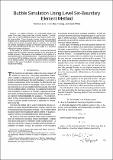| dc.contributor.author | Tan, Kiok Lim | |
| dc.contributor.author | Khoo, Boo Cheong | |
| dc.contributor.author | White, Jacob K. | |
| dc.date.accessioned | 2003-11-17T17:11:31Z | |
| dc.date.available | 2003-11-17T17:11:31Z | |
| dc.date.issued | 2003-01 | |
| dc.identifier.uri | http://hdl.handle.net/1721.1/3695 | |
| dc.description.abstract | In bubble dynamics, an underwater bubble may evolve from being singly-connected to being toroidal. Furthermore, two or more individual bubbles may merge to form a single large bubble. These dynamics involve significant topological changes such as merging and breaking, which may not be handled well by front-tracking boundary element methods. In the level set method, topological changes are handled naturally through a higher-dimensional level set function. This makes it an attractive method for bubble simulation. In this paper, we present a method that combines the level set method and the boundary element method for the simulation of bubble dynamics. We propose a formulation for the update of a potential function in the level set context. This potential function is non-physical off the bubble surface but consistent with the physics on the bubble surface. We consider only axisymmetric cavitation bubbles in this paper. Included in the paper are some preliminary results and findings. | en |
| dc.description.sponsorship | Singapore-MIT Alliance (SMA) | en |
| dc.format.extent | 212592 bytes | |
| dc.format.mimetype | application/pdf | |
| dc.language.iso | en | |
| dc.relation.ispartofseries | High Performance Computation for Engineered Systems (HPCES); | |
| dc.subject | level set method | en |
| dc.subject | boundary element method | en |
| dc.subject | bubble dynamics | en |
| dc.subject | topological change | en |
| dc.title | Bubble Simulation Using Level Set-Boundary Element Method | en |
| dc.type | Article | en |
